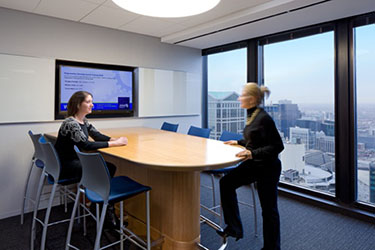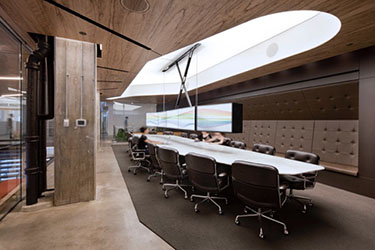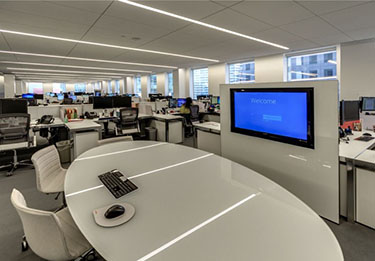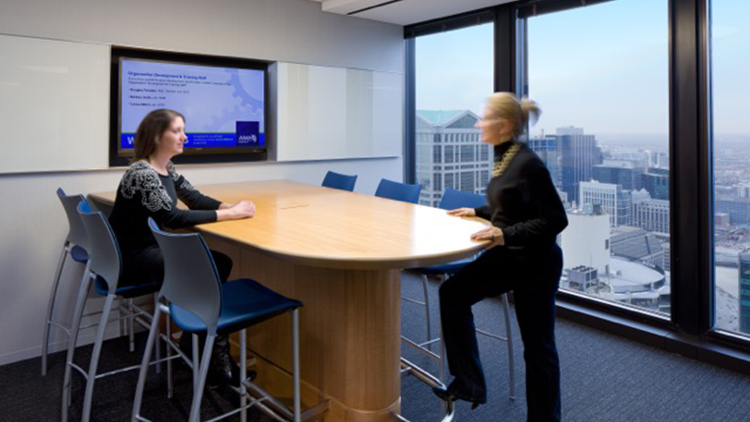Workplace audiovisual systems are evolving rapidly and with many factors contributing to the changes. Some in the industry are concerned that process is happening too quickly. Our experience in the field suggests otherwise: we could streamline the evolution of workplace AV for the benefit of everyone, from manufacturer to end user. To do so, we need to listen to the people with the most critically valuable information: the technology managers and the control systems programmers.

A collaborative space at The American Medical Association. Photo by Paul Morgan, courtesy IA Interior Architects.
Of course, everyone in the industry brings a valuable perspective. The problem is that, for a long time, the driving forces of evolution have been top-down. Manufacturers and integrators—highly knowledgeable in their own rights—have driven the conversation with users based on the product they have available to sell. But recently the balance has shifted. The technology market beyond the workplace walls is responding in real time to consumerization, presenting the market with simple, responsive, user-friendly devices for both AV and IT applications. Now end users in the workplace—who feel that they know how they should be able to interface with systems—are bringing to the “chief user,” the technology manager, their suggestions and complaints.

Style meets cutting-edge AV at Horizon Media. Photo by Magda Biernat, courtesy A+I Architecture.
The technology manager is then often in an unenviable position, advocating for the end users in negotiations with the integrator or the manufacturer. This is not to say that manufacturers and integrators are entirely unresponsive to the needs of end users. At the InfoComm Show in Orlando this past June, the major buzz on the show floor was around technology for huddle rooms, the informal meeting spaces ideal for impromptu collaboration and intimate presentations that have become ubiquitous in office designs over recent years. It was clear that manufacturers, at least, were responding to the talk of simplification and ease of use.
But there is still resistance within the industry to any move away from an industry-led model of development. As a result, I regularly see user interfaces that deserve to be set aside—not because they are obsolete, but because they are confusing and aggravating. When commercial AV user interfaces are designed badly, are difficult to use, or operate inconsistently, then they are less likely to become accepted and widely adopted, holding back the entire industry.

High-tech hub at Brookfield Properties NY: Photo by LSM Architects, courtesy VCA.
We need to dispense with the notion that the consumerization of the commercial AV marketplace is a bad thing. As technology professionals, we prize excellence in design and engineering. It only makes sense that the most widely adopted user interfaces are, in some important respects, the best designed. In the current workplace sector, thanks to innovation in manufacturing and integration, the hardware has already done most of the difficult work. Built to support easy plug-and-play configuration—with functions like 'look at me' buttons for instantly switching sources or aiming cameras at preset positions—the latest hardware should make tasks like videoconferencing easy for end users. But too often the interface presents unnecessary obstacles. Time spent struggling with controls to make a presentation or videoconference work represents lost productivity, but worse yet, creates anxiety and discomfort for the user.
Most end users are not AV professionals, but they don’t need to be to know what works well, and what doesn’t. Simple, elegant interfaces will win every time. If you don’t agree, consider how hardware connections are trending. On the end-user side, there’s zero nostalgia for the days of sorting through VGA and HDMI adapters before getting a meeting started.

Robert Fini, principal in the Technology Group, Cerami & Associates, Inc
Going forward, my advice is for the users to stick to their guns: keep demanding simpler, more intuitive interfaces and connections.
And for the manufacturers and integrators, keep listening to your customers. Be open to seeing things from a perspective outside the industry. A consumer-driven marketplace may seem like a huge headache, but the users’ voices have gone unheard for too long. Tuning in to what they are demanding will improve your product and streamline the process of users adopting new technology.
Robert Fini is a principal in the Technology Group for nationally renowned acoustics and technology consultancy Cerami & Associates, Inc. From the firm’s Philadelphia office, he manages multidisciplinary projects with a focus on audiovisual technology systems, for clients in the corporate, institutional, hospitality, healthcare, and government sectors.
INFO
Cerami & Associates
www.ceramiassociates.com
